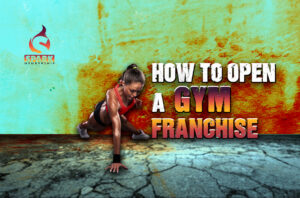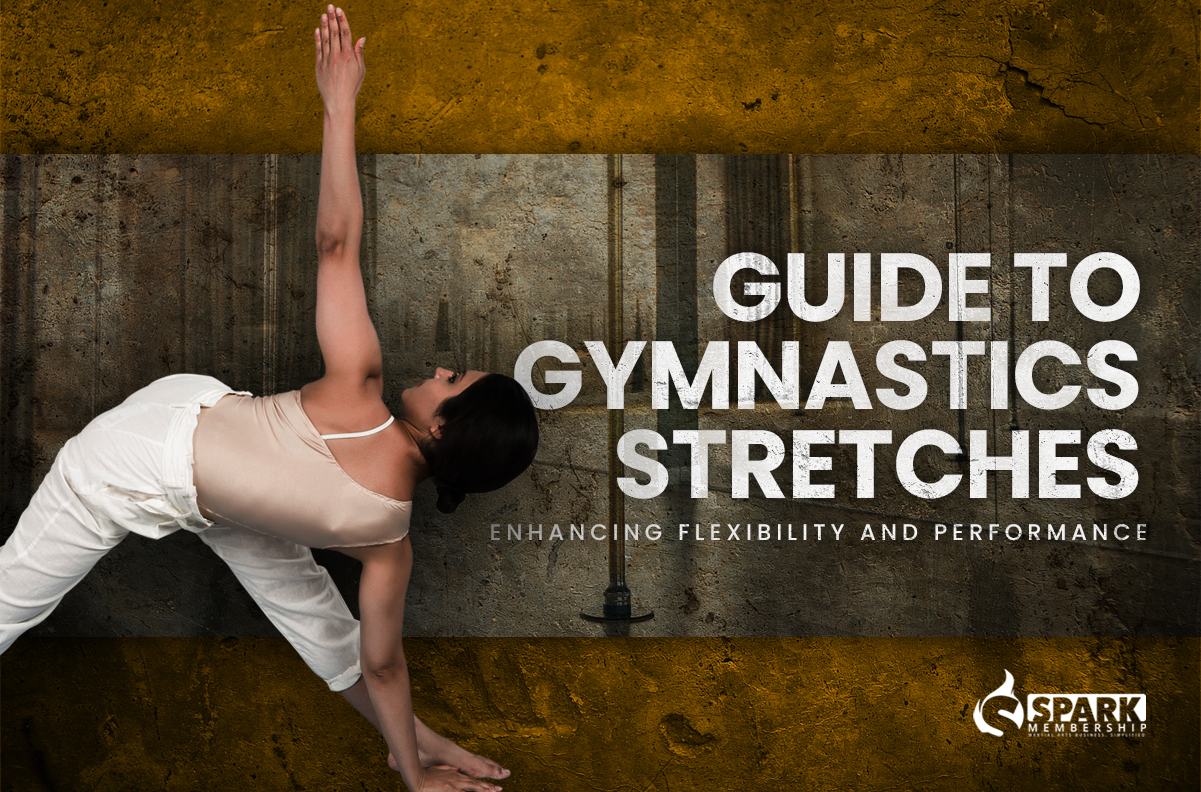
Are you leading a gymnastics class? We all understand the critical role stretching plays in shaping champions. Flexibility isn’t just about reaching further; it’s the foundation of every pirouette and vault. This guide zeroes in on key stretches that elevate flexibility, enhance performance, and minimize injury risks. Tailored for gymnastics instructors and club owners, it’s packed with insights to enrich your training sessions. Ready to transform your gymnasts’ routines with stretches that unlock their full potential? Let’s dive into creating a more dynamic, injury-resistant team.
The Role of Flexibility in Gymnastics
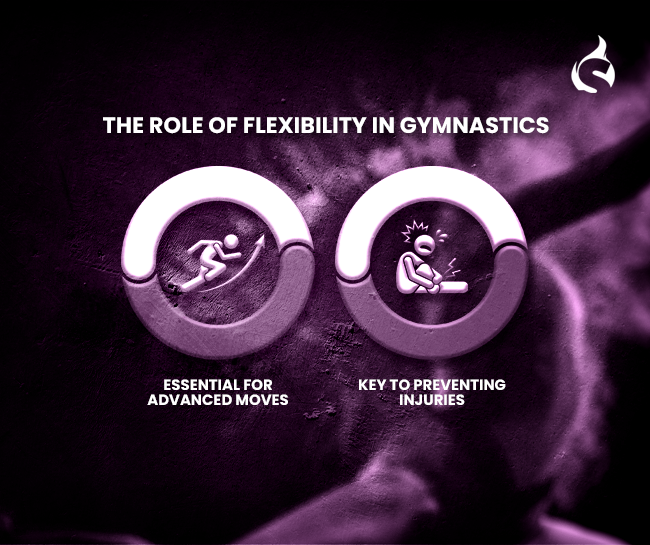
Flexibility isn’t just a part of gymnastics; it’s the backbone that enables athletes to perform complex moves with grace and reduces their injury risk. Here’s why it’s indispensable:
Essential for Advanced Moves
Flexibility allows gymnasts to achieve a greater range of motion, crucial for executing the sport’s intricate maneuvers with precision and artistry.
Key to Preventing Injuries
A flexible body is more resilient, significantly lowering the chance of strains and sprains by absorbing the rigorous demands of gymnastics training more effectively.
💡 In short, prioritizing flexibility training is not just about enhancing performance—it’s also about safeguarding athletes from injuries, ensuring they can pursue their passion with fewer setbacks.
Essential Stretching Routines for Gymnasts
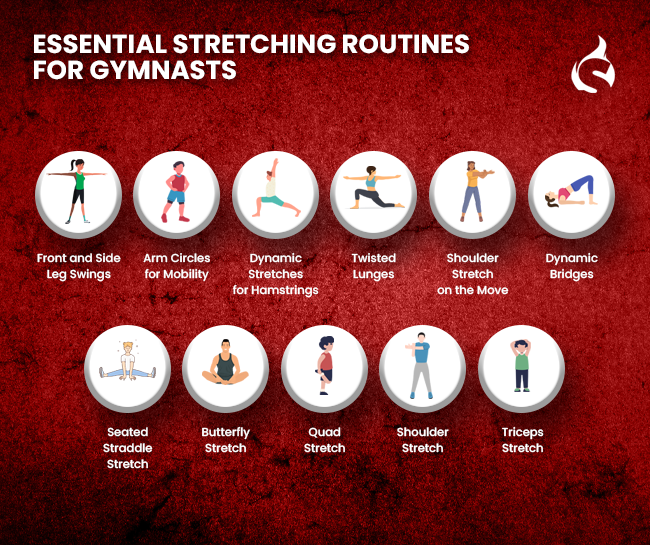
Incorporating both dynamic and static stretching into gymnastics training is vital for enhancing flexibility, performance, and reducing the risk of injury. Here’s a comprehensive guide to both stretching types, seamlessly integrated for optimal gymnastics conditioning.
- Front and Side Leg Swings: Find a stable support like a wall or a ballet barre. Swing your leg forward and backward, reaching for maximum range each time, for 10 swings per leg. Then, switch to lateral swings, moving your leg across your body for another 10 swings per leg.
- Arm Circles for Mobility: Position your feet shoulder-width apart. Extend your arms to form a T with your body. Start rotating your arms in small circles, gradually enlarging them. After 10 seconds, switch the rotation direction, continuing for another 20 seconds total.
- Dynamic Stretches for Hamstrings: With feet hip-distance apart, take a step forward with the right foot, keeping it straight. Lean forward at the hips, reaching towards your foot. Alternate legs, aiming for 10 reps each, to dynamically stretch your hamstrings.
- Twisting Lunges: Initiate in a lunge, right leg forward, left leg back. Hands behind your head, twist your torso right, bringing your elbow towards the right knee. Swap sides after 10 reps, ensuring both sides are equally worked.
- Shoulder Stretch on the Move: Stand straight, stretch your right arm across your body. With your left hand, gently pull the right arm closer, stretching the shoulder. Alternate after a few seconds, completing 10 reps per arm.
- Dynamic Bridges: Lying on your back, knees bent, feet planted, and hands by your ears, press into your palms and feet lifting into a bridge. Lower and repeat for 10 fluid motions, focusing on engaging your core and glutes.
- Seated Straddle Stretch: Sit on the floor with your legs extended out to the sides as wide as comfortably possible. Keep your back straight as you hinge at the hips, reaching forward with your hands. Hold at the deepest point of the stretch for 15-30 seconds, targeting the inner thighs and groin.
- Butterfly Stretch: While seated, bring the soles of your feet together in front of you, allowing your knees to fall out to the sides. Hold onto your feet or ankles and gently press your knees towards the floor, using your elbows for a deeper stretch. Maintain this position for 15-30 seconds to stretch the inner thighs and hips.
- Quad Stretch: Stand near a wall or chair for balance if needed. Bend one knee, bringing your heel towards your buttock, and grasp your ankle with your hand. Keep your knees close together and push your hip forward to intensify the stretch. Hold for 15-30 seconds, then switch legs. This stretch targets the front of the thigh.
- Shoulder Stretch: Bring one arm across your body at shoulder height. Use your other hand to press the arm closer to your chest, stretching the shoulder. Hold for 15-30 seconds, then switch arms. This stretch is excellent for relieving tension in the shoulders.
- Triceps Stretch: Raise one arm overhead, then bend your elbow to bring your hand towards the opposite shoulder blade. With your other hand, gently press on the bent elbow to deepen the stretch. Hold for 15-30 seconds before switching arms, targeting the triceps and upper back.
Following these dynamic stretches, transitioning to static stretching can further enhance flexibility, allowing muscles to relax and lengthen after your workout. Static stretches involve holding a position for a period, such as touching your toes or holding a side stretch, which can improve flexibility and cool the body down after dynamic movements.
Daily Stretching Routine for Gymnasts
A daily stretching routine is vital for maintaining and enhancing flexibility. This routine should include a mix of dynamic and static stretches, focusing on major muscle groups used in gymnastics. Frequency and duration are key; stretching should be done daily, with each static stretch held for at least 30 seconds to achieve the best results.
Implementing a Stretching Regime in Your Gymnastics Classes
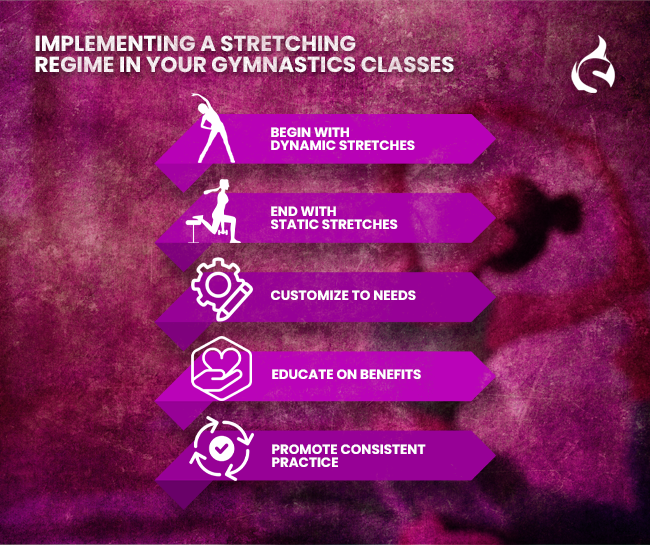
Implementing a stretching regime in gymnastics classes is key to enhancing flexibility and safety. Here are the essentials:
- Begin with Dynamic Stretches: Warm up muscles at the start of each class to prepare for physical activity.
- End with Static Stretches: Incorporate static stretches at the end for cooling down and improving flexibility.
- Customize to Needs: Tailor routines to individual gymnast’s flexibility levels and progress.
- Educate on Benefits: Highlight the importance of stretching for injury prevention and performance.
- Promote Consistent Practice: Encourage daily stretching outside of class to maximize benefits.
💡 Focusing on these core principles ensures an effective stretching regime that supports gymnasts’ performance and wellbeing.
Stretching is a foundational element of gymnastics that directly impacts flexibility, performance, and injury prevention. By incorporating the stretches outlined in this guide, gymnast club owners and instructors can significantly enhance their gymnasts’ abilities. Remember, the journey to improved flexibility is ongoing; consistently incorporating these stretches into routines will yield the best results. Let’s stretch our way to excellence, one bend and twist at a time.
Ready to streamline your gymnastics club management? Spark Membership Software simplifies administrative tasks, membership management, scheduling, and progress tracking. Say goodbye to paperwork headaches and hello to more time nurturing your gymnasts’ talents. Join clubs already benefiting from Spark.



